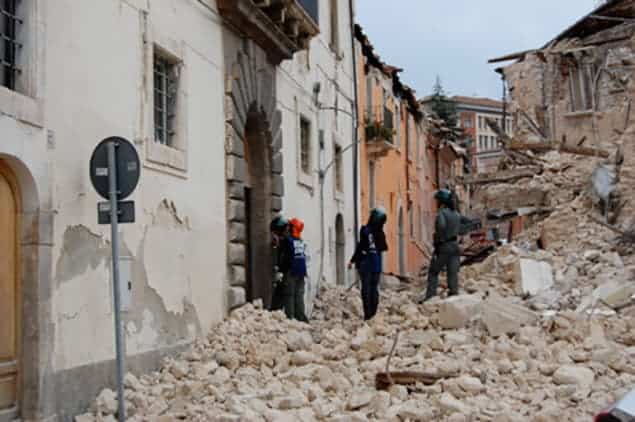
Six of the seven scientists and engineers who were controversially found guilty of manslaughter for the role that they played in the 2009 L’Aquila earthquake have been cleared after a month-long appeal trial. However, one expert – seismic engineer Bernardo De Bernardinis, who in 2009 was deputy head of Italy’s Civil Protection Department (DPC) – remains convicted, although his six-year sentence has been reduced to two years.
The earthquake that struck L’Aquila, which is the capital of the Abruzzo region in central Italy, in the early hours of 6 April 2009 left hundreds dead and the city in ruins. A couple of months before the quake hit there was a “swarm” of regular, small quakes with maximum magnitudes of about 2.5. Then on 30 March that year, the tremors suddenly rose in magnitude to 4.1. In response, the then head of Italy’s DPC, Guido Bertolaso, ordered a meeting of the Major Risks Committee (MRC) for the following day.
Present at the MRC meeting were volcanologist Franco Barberi of the University of Rome; geophysicist Enzo Boschi of the Istituto Nazionale di Geofisica e Vulcanologia (INGV); seismic engineer Gian Michele Calvi of the University of Pavia; seismologist Claudio Eva of the University of Genova; seismic engineer Mauro Dolce, director of the DPC’s seismic risk office; seismologist Giulio Selvaggi of the INGV; and De Bernardinis. They reportedly concluded that a swarm did not increase the risk of a major earthquake, and that no action was needed.
Six days later, however, an earthquake of magnitude 6.3 struck, killing more than 300 people, injuring about 1600 and leaving some 40,000 homeless. In August 2009 a number of L’Aquila citizens filed a lawsuit against the seven MRC members who, the prosecution argued, had provided “inaccurate, incomplete and contradictory” information about the threat posed by the preceding tremors. Following a trial that lasted more than a year, in October 2013 the seven MRC members were found guilty of manslaughter and given a six-year sentence – two years longer than those requested by the prosecutor.
In a 943-page document explaining the reasoning for the conviction and the sentences, trial judge Marco Billi stated that the defendants’ “level of guilt [was] particularly high” and that this guilt is accentuated by their “conscious and uncritical” participation in a “media operation” ordered by Bertolaso.
The appeal trial began last month in the L’Aquila courtroom before a three-judge court. The judges reached their verdict yesterday, overturning the initial ruling for the six scientists and reducing the sentence for De Bernardinis from six to two years. It is likely that both verdicts will now be challenged in Italy’s Supreme Court, which may not hear the case until 2016.
“As I read it, the scientists have all been acquitted, while [De Bernardinis] who made the public statements that downplayed any risk was convicted of some counts. This seems to me to be an appropriate criminal outcome,” says Lucy Jones, who is science adviser for risk reduction at the US Geological Survey in California. “The scientists provided an analysis of the seismic hazard that was technically correct, and I see nothing that could be called criminally negligent.”
However, Jones adds that seismologists should not consider the result of the appeal as a vindication of their current procedures. “A technically correct prediction that is not used correctly is not a good prediction. We need to take responsibility for how the information is communicated,” adds Jones. “There is a lot of research going on in disaster communication that we should use to take our uncertain information and make it useful.”



